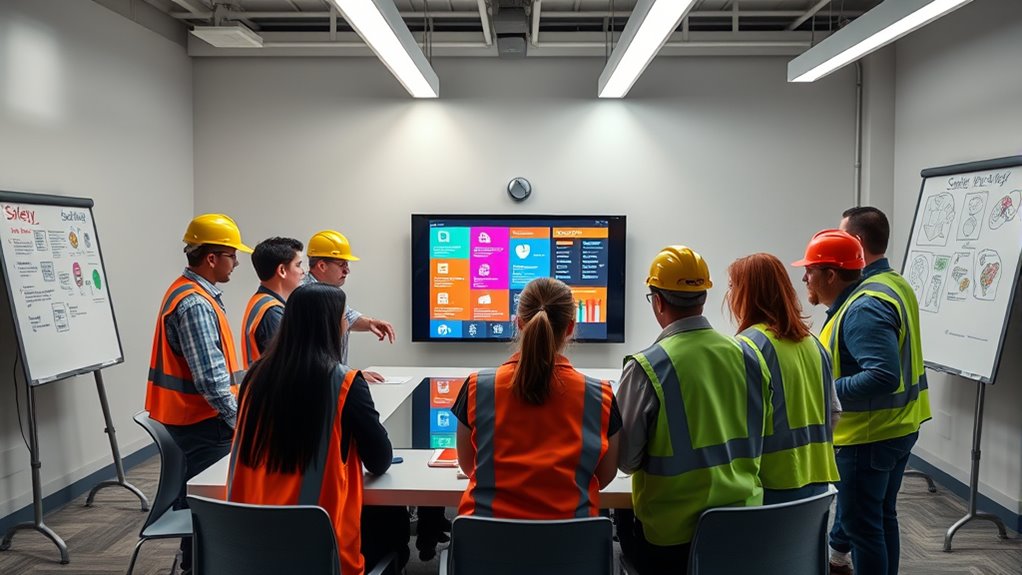To build a safety culture, commit to leadership that visibly prioritizes safety through consistent actions and open communication. Engage employees by encouraging their participation, valuing their input, and fostering shared responsibility. Reinforce safety practices regularly with training and audits, and recognize safety milestones to motivate continuous improvement. Trust grows when leadership is involved and transparent, making safety a core part of daily routines. Keep exploring strategies that transform safety into everyone’s shared core value.
Key Takeaways
- Foster open communication channels for employees to voice safety concerns and suggest improvements.
- Demonstrate leadership commitment through visible actions and consistent safety practices.
- Provide regular safety training and conduct audits to reinforce awareness and identify hazards proactively.
- Recognize employee contributions and encourage ownership to build shared responsibility for safety.
- Celebrate safety milestones and continuously reinforce safety as an organizational core value.

Have you ever wondered what truly sets a safe workplace apart? It’s not just about having the right equipment or strict rules; it’s about fostering a culture where safety becomes second nature. Building this kind of environment requires more than policies—it demands active participation from everyone, starting from the top. Employee engagement plays a pivotal role here. When your team feels involved, valued, and responsible for safety, they’re more likely to follow protocols and look out for one another. You need to create channels for open communication, where employees can voice concerns or suggest improvements without fear of retaliation. Recognize their contributions and encourage them to take ownership of safety practices. This collective effort transforms safety from a mandated task into a shared priority. But none of this can happen without leadership commitment. Leaders must demonstrate unwavering dedication to safety, not just in words but through consistent actions. When management visibly prioritizes safety—by participating in training, addressing hazards promptly, and rewarding safe behaviors—they set a powerful example. This dedication signals to everyone that safety isn’t a secondary concern but a core value. It’s essential that leadership communicates openly about safety goals, keeps everyone informed about policies, and ensures resources are allocated appropriately. When employees see their leaders genuinely invested, they’re more likely to mirror that attitude. Building a safety culture isn’t a one-time effort; it’s an ongoing process that requires continuous reinforcement. Regular training sessions, safety audits, and feedback loops help keep safety at the forefront. Recognize and celebrate safety milestones to motivate ongoing engagement. Incorporating safety culture practices is proven to improve overall organizational safety performance. Remember, safety isn’t just about avoiding accidents—it’s about creating an environment where everyone feels secure and empowered to speak up. When employees see leadership actively involved and truly committed, they develop a sense of trust and shared responsibility. This trust encourages proactive safety behaviors, where everyone looks out for hazards before they become problems. Ultimately, a safety culture thrives when employee engagement and leadership commitment work hand in hand. You’re not just enforcing rules—you’re cultivating an environment where safety is ingrained in daily routines. This approach leads to fewer accidents, higher morale, and a more resilient organization. By making safety a core value that everyone owns, you’re building a workplace where everyone is invested in keeping each other safe, and that’s what truly makes a difference in any organization.
Frequently Asked Questions
How Can Leadership Influence Safety Culture Effectively?
You can influence safety culture effectively by demonstrating strong leadership engagement and prioritizing open communication strategies. When you actively participate in safety initiatives and consistently reinforce safety as a core value, employees follow your example. Clear, transparent communication encourages trust and accountability, making safety a shared goal. By visibly supporting safety protocols and listening to staff concerns, you foster a culture where safety becomes everyone’s responsibility.
What Role Does Employee Feedback Play in Safety Culture?
While management sets policies, employee feedback truly shapes safety culture. You play a vital role through employee engagement, sharing insights and concerns that highlight real issues. Feedback mechanisms enable you to voice safety suggestions or report hazards, fostering trust and collaboration. When you actively participate, safety becomes a shared responsibility, leading to continuous improvement. Your input helps identify risks early, making the workplace safer and more resilient for everyone involved.
How Do Organizations Measure Safety Culture Progress?
You measure safety culture progress by evaluating safety climate and perceptions through surveys, interviews, and observations. Track changes over time to see if safety attitudes improve and if employees feel more committed to safety practices. Use tools like safety climate questionnaires to gather insights, analyze trends, and identify areas needing attention. Regularly reviewing these metrics helps you understand how your safety culture evolves and where to focus improvement efforts.
What Are Common Challenges in Building Safety Culture?
You might face challenges like inconsistent safety training and reluctance to report hazards. Employees may fear repercussions, making hazard reporting difficult. To overcome these, promote open communication and guarantee safety training is ongoing and engaging. Encourage a culture where everyone feels responsible for safety. Address concerns promptly, and reinforce positive behaviors. These steps help you build a strong safety culture where safety training and hazard reporting are seamless and effective.
How Can Safety Culture Be Sustained Long-Term?
To sustain safety culture long-term, you need to focus on consistent behavior reinforcement and ongoing safety training. Keep safety top of mind by regularly recognizing safe behaviors and addressing hazards promptly. Encourage open communication where everyone feels comfortable sharing concerns. Reinforce safety messages through continuous training sessions and updates. By maintaining these practices, you create a resilient safety culture that endures and evolves with your organization’s needs.
Conclusion
Remember, building a safety culture is like tending a delicate garden—you need consistent care, attention, and patience. When everyone nurtures safety, it blossoms into a sturdy, resilient landscape that protects and empowers. Don’t let complacency be the weeds that choke your progress. Instead, cultivate open communication and shared responsibility, turning your organization into a fortress of safety where everyone feels valued and secure. Keep tending that garden, and watch safety flourish at every turn.









